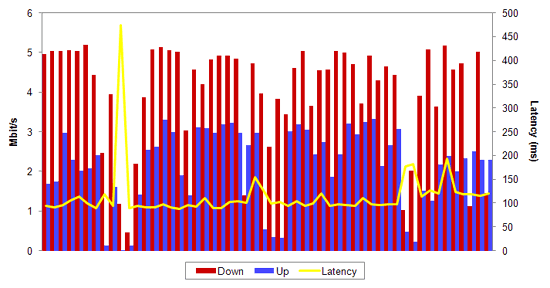July 7, 2011

I had the chance to carry out a real-world road test of Verizon Wireless's 4G-LTE service recently. On a week's trip to New York for Light Reading's annual Mobile Backhaul & Core event, and then on to Silicon Valley, I was able to put the world's preeminent LTE network through its paces.
My conclusion: It's better than any mobile network I've ever used. It delivers substantially better speeds than advanced HSPA networks and sets a new performance baseline for mobile broadband.
To run the tests, I used a Novatel 4G-LTE MiFi device, paired with a couple of smartphones and a laptop, and used the service as the typical business traveler would – in that I needed access at hotels, in conference rooms, in meetings, at the airport, traveling in cars, and at restaurants and bars. In other words, this is a real-world review of mostly typical usage scenarios.
Certainly the service felt fast and reliable, but to get a more objective view I ran a series of tests using the Speedtest.net app on the new Motorola Atrix smartphone I also happened to have on review. The 50-odd results are by no means a definitive measure of network performance, but do reflect real-world locations, usage and coverage. The results are shown in the chart below:
Bear in mind that most of these results were indoors or from moving vehicles – both of which are factors that normally reduce throughput – and not generated where I had line-of-sight to the antenna or was particularly close to the base station. In fact, I never especially looked for an LTE antenna during the week of testing.
To summarize, my results were as follows:
Downlink Performance: Speeds of 4-5 Mbit/s were common on the downlink and virtually always above 2 Mbit/s. Interestingly, I never got beyond 5 Mbit/s. I'm not sure if that is because the network is configured to generate that type of per-user throughput, or of if didn't burst higher just because I was never in good enough signal conditions to achieve high peak speeds. For reference, if you consistently get 1 Mbit/s downlink performance on an HSPA network in London you're doing well these days.
Uplink Performance: This was a revelation and consistently delivered 1 Mbit/s and often bursting to 3 Mbit/s. This compares favorably with to the 200-300 kbit/s I'm used on to on HSPA and makes applications such as video calling viable. It's interesting to note that TeliaSonera has also highlighted uplink speeds on its first LTE networks came as pleasant surprise.
Latency: This is harder to call. At around 100ms roundtrip times were, without question, good. But they weren't absolutely stunning either, and as often as latency would drop down to 93ms or 94ms at best, it would rise to 110ms to 120ms (although hardly ever beyond that). This is by no means poor performance for a mobile broadband network and two years ago would have been incredible, but after a period of intense optimization, latency in the most advanced HSPA networks is now close to par with these numbers. It's possible the latency figures reflect the larger cell sizes of 700MHz, or perhaps the underlying IP and EPC network engineering? In any case, it is an area where ongoing optimization will improve performance over time. This is still a very new network, after all.
Beware of reading too much into these speed-test figures, which I think underplay just how good the network is from an end-user perspective. My anecdotal experience was that the service is nothing short of superb. Being able to pull a solid 4 Mbit/s while in a vehicle moving at 70 mph is incredible performance. Maintaining a broadband connection in a taxi though the urban canyons of New York City is a true feat of radio network design. And being able to make Skype calls at 50-60 mph on the Bayshore Freeway is, well, kind of fun (for nerds, anyway).
Note, too, that these are all examples that highlight the value of 700MHz spectrum and how it enables the combination of speed and coverage to make a service compelling to users. No doubt 800MHz in Europe will be similar.
The Novatel MiFi unit was easy to use (it has only one button), hangs on to the LTE signal incredibly well – as the vehicle tests demonstrate – and kicks out a decent WiFi signal. Under heavy use (streaming video, or from a moving vehicle) the battery would drain within a few hours and the MiFi would get warm – hot, even. But that's to be expected: Heavy data usage consumes mobile device battery capacity and there's no way around that. My 3G personal hot spot is the same.
For "snacky" smartphone use, the MiFi drops to dormant mode to save power, and with a laptop it powers off USB, so for practical purposes it worked out pretty well. In a hotel room it could be plugged in and forgotten about – it felt like using always-on, premium WiFi.
— Gabriel Brown, Senior Analyst, Heavy Reading
Read more about:
OmdiaYou May Also Like









